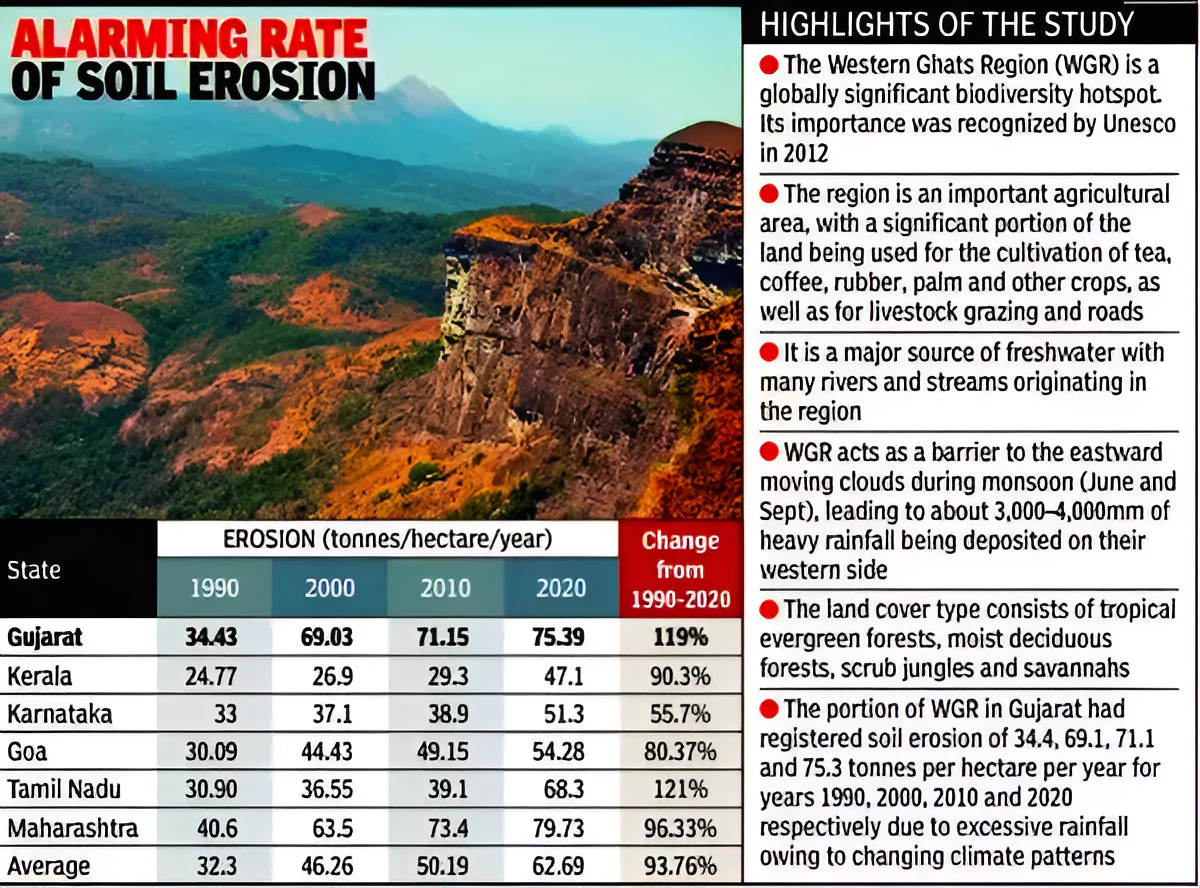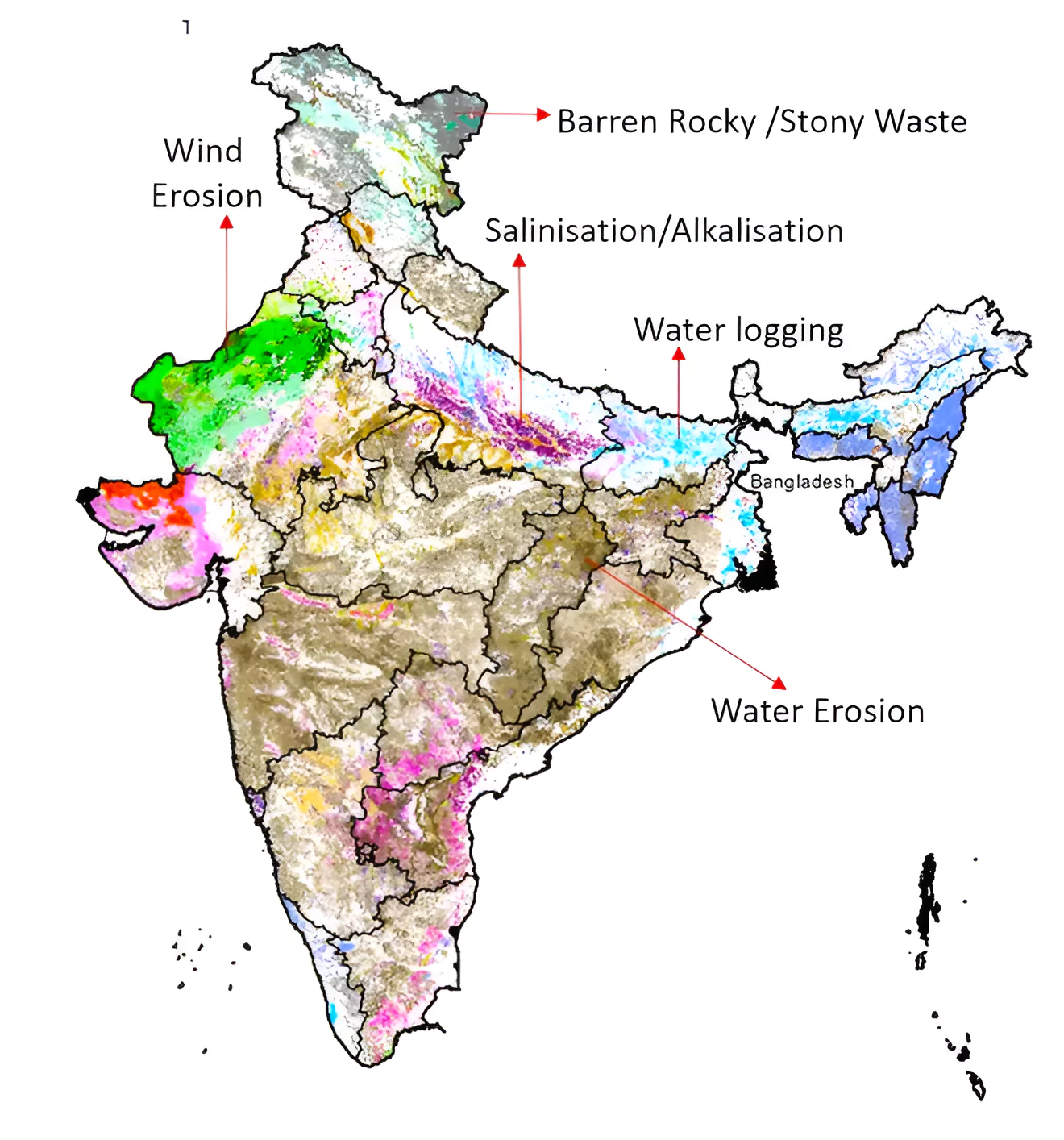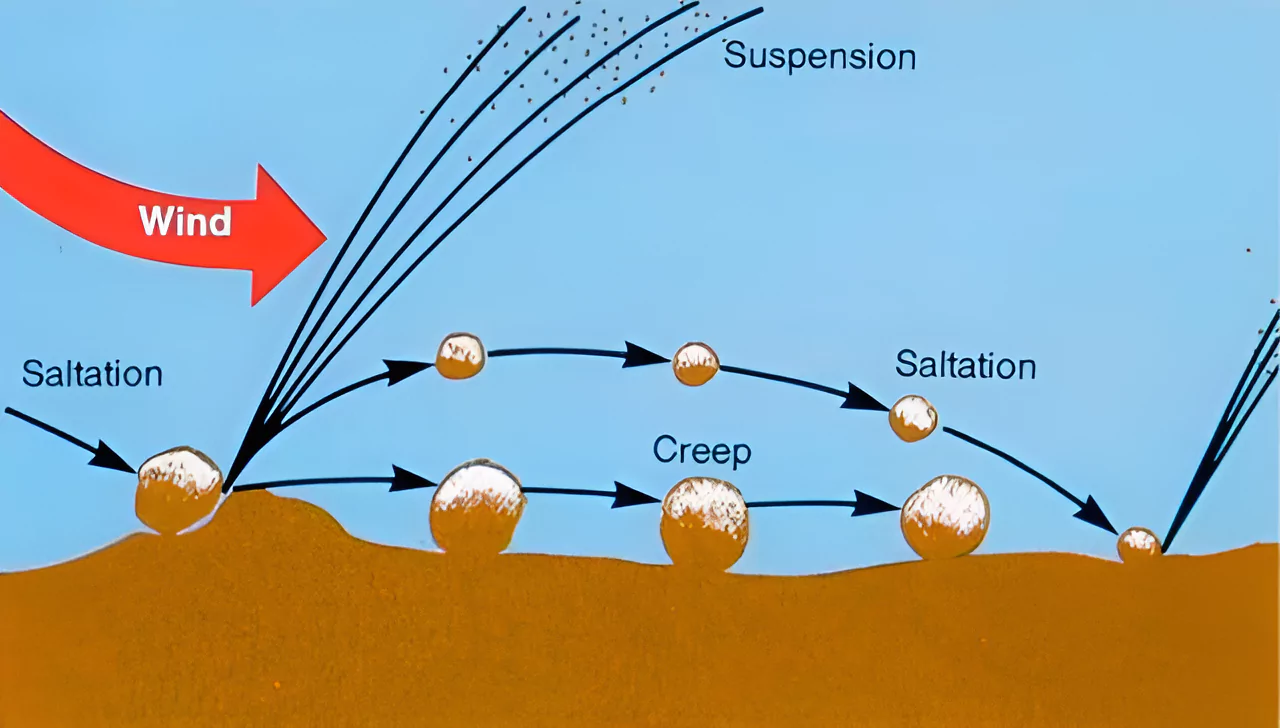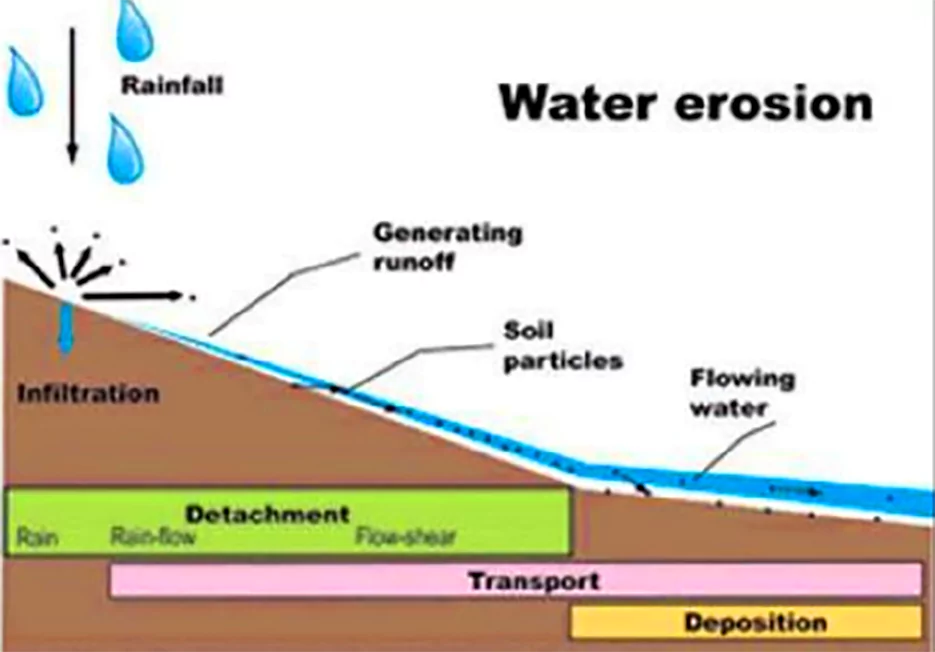Context
A recent study has raised concerns about the alarming rate of soil erosion occurring in the Western Ghats Region (WGR).

Soil Erosion in Western Ghats (Gujarat): About the Study
- Methodology of the Study: The IIT-Bombay study was conducted using data from LANDSAT-8, Digital Elevation Model (DEM), and rainfall records to estimate soil loss rates using the Universal Soil Loss Equation (USLE) method.
Key Findings of the Study
-
- The study reveals a 94% increase in soil erosion rates across the Western Ghats Region (WGR) between 1990 and 2020.
- Tamil Nadu and Gujarat: Portions of the WGR in Tamil Nadu and Gujarat registered 121% and 119% increase in soil erosion respectively since 1990.
 Kerala and Karnataka: They witnessed a concerning increase of 90% and 56% respectively.
Kerala and Karnataka: They witnessed a concerning increase of 90% and 56% respectively. - Goa: It displayed equally alarming trends, with a rise of 80% in soil erosion during the study period.
- Maharashtra: It saw a substantial increase of 97%.
-
Reason for Soil Erosion:
- The increasing rainfall erosivity factor during the subsequent years was a reason for the massive soil erosion.
- Climate change and unsustainable land use are accelerating soil erosion.
- Urgent action is needed to minimize human impact and ramp up conservation efforts.
What is Soil Erosion?
- Soil erosion is the process by which soil is removed from the Earth’s surface by exogenetic processes such as wind or water flow, and then transported and deposited in other locations.
Western Ghats Region (WGR)
- Geographical Extent: The WGR is spread across six Indian states including Tamil Nadu, Kerala, Karnataka, Goa, Maharashtra, and Gujarat.
- Biodiversity Hotspot: It is a biodiversity hotspot of global importance recognized by UNESCO in 2012.
- Soil: Red soils are typically found on the western side of the Ghats where the slopes are steep and the rainfall is high. These soils are rich in iron and aluminium oxides and are typically clayey in texture.
- Significance: They moderate the tropical climate of the region by intercepting the southwest monsoon leading to an orographic rainfall region, thus providing for a non-equatorial tropical evergreen forest ecosystem.
|
Data On Soil Erosion in India

- According to the National Bureau of Soil Survey and Land Use Planning, 146.8 million hectares, around 30% of the soil in India is degraded.
- Of this, around 29% is lost to the sea, 61% is transferred from one place to another, and 10% is deposited in reservoirs.
- Since the 20th century, soil degradation has accelerated due to man-made factors like mining, deforestation, overgrazing, monoculture farming, excessive tillage, and the use of chemical fertilisers and pesticides.
Natural Causes of Soil Erosion
- Strong Winds: Heavy winds remove dry tiny earth particles, which is a typical problem in semi-arid regions leading to desertification.
- Climate change: Abnormal rainfalls or temperature leaps destroy the field surface. It leads to stunted vegetation growth that reduces field cover and exposes it to rains and winds.
- Rainfall and Flooding: Excessive rains wash away topsoil particles, while large raindrops hit the field surface and destroy it with heavy splashes.
- Running currents during floods is another cause of soil erosion.
- Wildfires: Trees and shrubs slow down water run-offs. When forests or buffer zones are destroyed by wildfires, water streams have no obstacles in their way.
Anthropogenic Causes of Soil Erosion
-
Unscientific Agricultural Practices:
-
- Tilling or Ploughing: It increases the chances of erosion because it disturbs the natural soil surface and protective vegetation.
- Continuous cropping: Continuous cropping of the same land and extension of cultivation of marginal and sub-marginal lands encourages soil erosion.
- Cultivation on mountain slopes: Without appropriate land treatment measures such as bounding, terracing and trenching, it can cause soil erosion and loss of soil nutrients.
- Monoculture: It includes the practice of planting of the same variety of crop in the field.
- Overgrazing: Trampling and grazing by cattle destroys the vegetation of the area. In the absence of adequate vegetative cover the land becomes highly susceptible to both wind and water erosion.
-
Economic Activities:
- The extraction of useful natural resources such as metals, minerals and fossil fuels etc., from the land causes serious disturbance to the land leading to soil erosion and drastic changes in the landscape.
-
Developmental Activities:
-
- Soil erosion may also occur because of various developmental activities such as housing, transport, communication, recreation, etc.
Types of Soil Erosion
Soil erosion is broadly categorized into different types depending on the agent which triggers the erosion activity.

-
Geologic Erosion:
- Geologic erosion sometimes referred to as natural or normal erosion represents erosion under the cover of vegetation. It includes soil as well as soil eroding processes that maintain the soil in favourable balance, suitable for the growth of most plants.
- The rate of erosion is so slow that the loss of soil is compensated by the formation of new soil under natural weathering processes.
-
Wind Erosion:
- Erosion is most often witnessed in dry areas wherein strong winds brush against various landforms, cutting through them and loosening the soil particles, which are lifted and transported towards the direction in which the wind blows. Ex-Sand dunes and mushroom rocks structures, typically found in deserts.

-
- In water erosion, the water acts as an agent to dislodge and transport the eroded soil particle from one location to another.
Impact of Soil Erosion
In India almost 130 million hectares of land, i.e. 45 % of total geographical surface area, is affected by serious soil erosion through gorge and gully, , cultivated wastelands, sandy areas, deserts and water logging. Its major impacts include:
-
Effects of Soil Erosion on Agriculture:
- Eroded farmlands degrade and become unsuitable for agricultural activities.
- Soil organic matter content in most cropland soils of north western India and elsewhere is often less than 0.5%. This leads to low and stagnating crop yields.
- Soil organic matter (SOM) can be defined as organic materials found in soil that are, or have been, part of living organisms.
-
Losses of Topsoil:
- Topsoil is the richest earth’s layer with organic matter and nutrients, so its removal by water or wind worsens field fertility.
- It can take 500 to 1,000 years for one inch of topsoil—the upper layer of soil containing the most organic matter and microorganism to form.
- As of 2017, the country saw an average soil erosion rate of 16.35 tonnes per hectare per year, a rate significantly higher than the 2020 global average of just 2.4 tonnes per hectare per year.
- Soil erosion has always occurred naturally, but today, topsoil loss from erosion due to agriculture surpasses the rate of soil formation.
-
Soil Acidification:
- A lack of organic matter may increase field acidity, which slows down crop development and exposes farmlands to water and wind.
-
Losses In Planting Material:
- Water streams or dust storms take away seeds from the fields and destroy seedlings, which results in crop losses and decreases farmers’ profits.
-
Water Pollution:
- Soil erosion leads to sedimentation and contamination of water bodies with chemical substances from the fields, which, in turn, spoils the quality of irrigation water.
-
Environmental Impact of Soil Erosion:
- Soil erosion leads to decay in aquatic inhabitants and plants, biodiversity loss, sedimentation, etc.
-
Frequent Flooding Events:
-
- When forests are converted into pastures or fields, it leads to frequent flooding and these areas also lose their infiltration properties, which also contributes to flooding and waterlogging.
-
Loss of Biodiversity:
- Eroded lands have sparse vegetation and become completely bare over time. It leads to decay in local flora and fauna leading to ecosystem imbalance.
-
Reduced Greenhouse Gases Sequestration:
- Vegetation and trees are great carbon dioxide storage, but eroded lands can hardly support their growth.
- Soils could potentially sequester enough greenhouse gases in a year to equal about 5% of all annual human-made GHG emissions.
Government Initiatives taken to Prevent Soil Erosion in India
- Rashtriya Krishi Vikas Yojana: Under this, the Reclamation of Problem Soils has been started as a sub-scheme to assist in the reclamation of lands affected by alkalinity, salinity, and acidity.
- NABARD Loan- Soil & Water Conservation Scheme under RIDF: It aims to enhance the productivity of agriculture and its allied activities and in small river valleys, thereby improving the socio-economic set up of the people in the rural areas.
- Watershed Development Component of Pradhan Mantri Krishi Sinchayee Yojana 2.0: It aims to accelerate the economic growth rate of rainfed areas agriculture.
- Watershed Development Project in Shifting Cultivation Areas (WDPSCA): It aims to protect hill slopes of jhum areas through soil and water conservation measures on a watershed basis.
|
Management/ Prevention of Soil Erosion
- Crops Production On Suitable Lands: Some terrains are extremely prone to erosive processes, so they should not be used for farming without certain preventive measures to mitigate the risks.
- Besides, each field type requires specific management to protect soil from erosion.
- Terracing And Contour Farming: Terrace farming is used to grow crops on steep hills. Contour farming decreases soil erosion because plants absorb water and ridges stop it from flowing, which mitigates the destruction risks.
- Plants with strong roots also fix the land and prevent it from sliding down the slope.
- Plant Vegetation: Planting crops help prevent soil erosion by ensuring continuous ground cover, while leaving the field bare promotes erosive processes. Provide soil cover in between the growing season with crop rotation and cover crop practices.
- Besides, crop rotation reduces soil erosion by fixing the land with alternatively planted deep-rooted crops. Additionally, sequences of high vegetation protect fields from the wind.
- The vegetation cover over sandy soils should be kept above 30%. Access of wind to the soil should be controlled by leaving the stubble or mulch on the soil.
- Mulching: Mulches like straw, dried weeds, or agro textiles don’t only protect the field from rains and wind but retain soil moisture, which protects the earth from cracking.
- Decomposed mulches of biological origin add nutrients and organic matter to the field, boosting fertility and improving its structure.
- No-Till Or Minimum Tillage: Reduction of farmland disturbance in the no-till approach can help reduce soil erosion. When soil aggregates and ground cover remain nearly untouched, erosive processes develop slowly.
- Rotational Grazing: When livestock grazes in the same place for a long time, it eats up nearly all vegetation. In turn, ground cover loss often provokes erosion.
- Thus, it is important to let the grazed areas regenerate by moving the cattle to other pastures.
- Drip Irrigation: Dripping systems supply tiny water drops to plant roots at the surface or underground without any destruction risks.
- Preventing Coastal Erosion: For this, protective vegetation along the beaches should be re-established.
- The dunes and the coastal system must not be disturbed. Further, construction of buildings and other development should be located behind the dune system.
- Preventing Stream Bank Erosion: For this, runoff water should be stored in the catchment by maintaining vegetation cover and as by constructing dams for storing water.
Also Read: Rising Human Wildlife Conflict in the Southern Western Ghats
| Prelims PYQ (2016):
‘Gadgil Committee Report’ and ‘Kasturirangan Committee Report’, sometimes seen in the news, are related to
(a) constitutional reforms
(b) Ganga Action Plan
(c) linking of rivers
(d) protection of Western Ghats
Ans: (d) |
![]() 30 Mar 2024
30 Mar 2024

 Kerala and Karnataka: They witnessed a concerning increase of 90% and 56% respectively.
Kerala and Karnataka: They witnessed a concerning increase of 90% and 56% respectively. 


